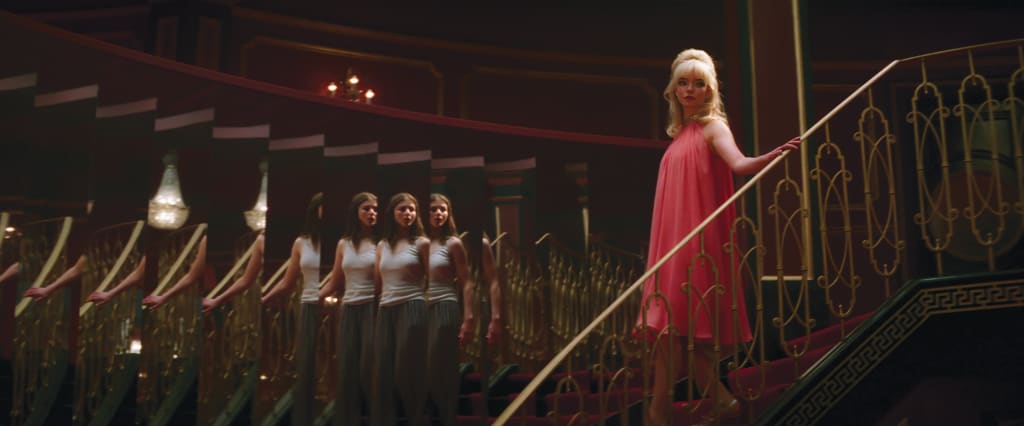Last Night in Darkness
A Reflective Review by J.C. Embree

You ascend the Raleigh Grande steps; tickets up on the phone, a close confidant on your arm. Said confidant had seen your worst shades of bitter tears, exploits and anger emerged from insecurities long sunken by the repression of awareness. The kind of pain that may have been concocted years in the making, but still unjustified for the mere microseconds at hand, particularly the ones out here in the present, at this movie theater with your confidant.
Steps ascended, the big metal door swung open, chairs reclined and seats opened. The lights go down. The film— Last Night in Soho, begins.
It plays as many films do, in three acts; but this one is special, through one mean or another.
Through one meaning each act is a different genre. Segwaying from an effeminate comedy held together by abrupt transitions and corn-syrup dialog. But even then you know something about its purity to be untrue. Like the land of Soho where it takes place, its places are picturesque but something runs deeper between the cracks of the pavements, under the sheet of dust in the older dwellings. The girl we follow sees ghosts. A take on the prospective would-be rom-com that we have not seen.
Said girl goes to bed; in a transition weaved so seamlessly that I now cannot fully recall, the girl is prowling the night again, strangely in pajamas, even more strangely in a different era of the titular Soho. She enters a concert hall, and one mirror-gaze later we see she is not her but a more illustrious young woman of blonde hair and stately attire. More important is the confidence she projects, and the way she dictates the people, more so the men than anyone else, around her. This is and is not the same girl from the introduction, the one who only spoke confidently to her grandmother. And yet the bodies between the girl in her pajamas and the young woman set to perform are swapped periodically; two women decades apart share the night.
Cinderella-esque as it may seem, otherworldly sights aside, it is not what the poster nor the teasers had promised. Said promotions promised the neon of Soho to not be seen for comfort but for caution; it’d promised hands bursting from floorboards to victimize our heroine.
Said promise would be delivered, just not in the ways you’d think.
For as it progresses, it descends to mystery. The girl is in 2021 but spends nights in the ‘60s, as the performer. And the performer’s new lover/manager, after just the right nod and scoff, followed by an “I don’t mind,” with no difference in shade or set design lets loose an uglier color that we learn is not a slip or lapse in judgment, but a reflection of true character and intent. He is a pimp.
We’d known the performer for twenty minutes, possibly less, and are still unsurprised when she storms away. Followed by the pimp, and the right combination of “It’s what you have to do,” “These are the men you have to please,” and such, she submits.
And it's from there that we the audience bear witness to the slow disintegration of the young dreamer’s strength and resilience, her hues of youth and confidence darken, spunk turned to spite and wit turns to rage.
It is not an everyday rage; it is not the product of a traffic cut-off, a scoffing notion instead of a tip, nor even an incident of a minor one-time assault. It is a rage borne of a powerlessness known only to those who have felt themselves physically restrained and forcibly undressed, a pain stemmed from the sadism of another, and an anguish blossomed by unprecedented doses of unwarranted touch. Again, and again, and again.
And the young girl, the 18-year-old from the country who’d gone to Soho for nothing more than a design school, feels the same as the performer; physically and mentally, night after night.
The story’s mysticism, stark use of bright colors and contrast, melodramatic approach and sheer bloodlust rings to the critics not of Soho or London, but of the Italian stories of old in tales told by Bava and Lenzi and Fulci, but above all Argento. Style propelled to modern times, however, it could’ve easily felt dated, but subverted all of that.
The film caters to the victims of closed lips and steady, if not tense dispositions, the kind that recoils at what was meant to be a comforting pat on the shoulder, and glues their eyes to the floor when spoken to by another; whether another has malintent is neither relevant toward the point. The not-knowing and uncertainty of intent, the dark void of Schrodinger’s cat, one reality ending in kinship and the other abuse– that is wholly the point.
The mystery, before your eyes, takes a final turn into a surreal psychological horror, the kind that explores the morality of murder, the nature of consequences, and hammering home the notion that people, no matter what you may do to them, can find ways to trap you with the past, and can literally line the walls which you dwell, physically and mentally.
And at a point toward a riveting climax, you peer over to your confidant, one you’d always held dear, in an ongoing rapport that has taken on so many changes so as to rival the wholly enigmatic and kaleidoscopic; and they are in tears.
The tears are small but present, shallow yet run deep; she is weeping for the performer, who’d had to endure the most monstrous sides of man in not only a loss of a dream but a loss of total selfhood; she also weeps for the young heroine, who had asked for even less, but through spirituality and empathy is enduring this anyway, and will likely for years after the story is told and the credits are wrapped shudder at the slightest touch or most passive look.
But you know she mostly finds despair on a level of pure relatability, the true projection of the story before her, a kinship with both protagonists. The filmmaker and the characters he wrote had managed to construct a relationship between themselves and your confidant; and while you and many can relate to powerlessness, failure, and a hardened disposition carved by duress, you cannot and will not fully understand the weight and form of the sadness washing through her now. You do what you can in the line of comfort, and share a smile of mutual understanding.
The film ends, and the two of you file out from the theater, your arm around her in a camaraderie molded from over a year of warm dialog and a truer and gentler intimacy. You talk about it in the car, during a late dinner, en route to her home. You agree the film is great; not for reasons of any standard film-critique shlock, nor for any pandering Oscar-bait reasons of social relevance, but of the sheer feelings emulated, brought on almost ironically in what was so clearly advertised as a project meant to tribute genre, and bring about stark technicalities of an old form of storytelling into a modern world.
When we go to movies, we know before, during, and after the feature that the characters told through light and shadow are not real and never were. And yet human beings find ways through those shapes and sounds to find not just likable beings or even relatable ones, but various versions of themselves that they were not aware of on the drive to the theater.
I know my taste to a good extent, and never minded going to the movies alone. Had I gone alone without my confidant, would I have enjoyed it nonetheless? Probably so. Would the night have been the same? Definitely not.
About the Creator
J.C. Traverse
Nah, I'm good.
Reader insights
Nice work
Very well written. Keep up the good work!
Top insight
Eye opening
Niche topic & fresh perspectives







Comments
There are no comments for this story
Be the first to respond and start the conversation.